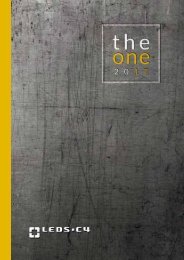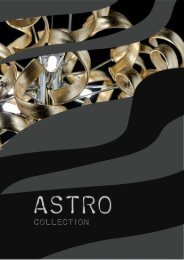RETAIL_2016
Create successful ePaper yourself
Turn your PDF publications into a flip-book with our unique Google optimized e-Paper software.
ORIGEN DEL DISEÑO DE<br />
LA ILUMINACIÓN<br />
THE ORIGIN<br />
OF LIGHTING DESIGN<br />
– RICHARD KELLY –<br />
La consideración de la luz eléctrica como un “material” de construcción<br />
fue reconocida en los años 20, y evolucionó hasta convertirse<br />
en una potente herramienta de diseño hacia mediados<br />
de siglo. Hasta entonces la iluminación arquitectónica había estado<br />
dominada por un punto de vista de ingeniería, centrada en<br />
los niveles de iluminación para tareas específicas.<br />
Richard Kelly (1910-1977) fue un diseñador de iluminación estadounidense,<br />
considerado uno de los pioneros del diseño de<br />
iluminación arquitectónica. Formado en iluminación teatral, Kelly<br />
aplicó su punto de vista escenográfico a la arquitectura, marcando<br />
un antes y un después en el diseño de iluminación. Sus ideas,<br />
aunque sencillas, fueron revolucionarias y han influenciado enormemente<br />
tanto la iluminación como la arquitectura moderna.<br />
The consideration of electric light as a construction “material”<br />
was first recognised in the 1920s, and became a powerful<br />
design tool towards the middle of the last century. Until then<br />
architectural lighting had been dominated by an engineering<br />
point of view, centred on the lighting levels required for specific<br />
tasks.<br />
Richard Kelly (1910-1977), an American lighting designer, is<br />
considered to be one of the pioneers of architectural lighting<br />
design. Kelly trained in theatrical lighting and applied his scenographic<br />
point of view to architecture, marking a turning<br />
point in lighting design. His ideas, although simple, were revolutionary<br />
and have enormously influenced both lighting<br />
and modern architecture<br />
TEORÍA DE LA ILUMINACIÓN<br />
CUALITATIVA<br />
La teoría de Kelly tiene diversas influencias, entre las que se encuentran<br />
los principios de la percepción, los elementos básicos<br />
de iluminación teatral o los efectos de luz que encontramos en la<br />
naturaleza. Kelly se aleja de la iluminancia uniforme como base<br />
para un proyecto de iluminación, sustituyéndola por la calidad<br />
de la luz.<br />
Establece tres funciones básicas:<br />
Luz para ver<br />
Luz para mirar<br />
Luz para contemplar<br />
THEORY OF QUALITATIVE<br />
LIGHTING<br />
Kelly’s theory has a number of influences, including the principles<br />
of perception, the basic elements of theatrical lighting<br />
and the light effects found in nature. Kelly moved away from<br />
uniform illumination as the basis for a lighting project, focussing<br />
instead on the quality of the light.<br />
He established three basic functions:<br />
Ambient luminescence<br />
Focal glow<br />
Play of brilliants<br />
17









